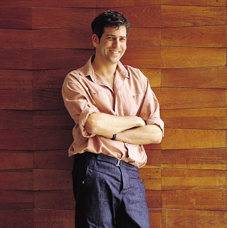Are you a journalist? Please sign up here for our press releases
Subscribe to our monthly newsletter:

Life is about decision making. From humans down to unicellular organisms it's all about striking the best deal, finding the greenest pastures or, say, choosing the quickest escape route from fire, predators, or noxious chemicals.
At the command post, on a submicron scale, lies the cell. First viewed by the human eye during the late 1600s but sporting billions of years of evolutionary polish, it easily rivals today's most advanced computers. On receiving information about its environment, the cell processes it, filters out irrelevant cues, cross-checks the extracted information with prior experience, and decides upon an appropriate 'output,' or response strategy.
Scientists have spent decades piecing together this picture of the cell's nuts and bolts. Yet its actual circuitry and time-dependent responses to environmental stimuli remain elusive. Pooling together computer science, a research tool derived from an ancient jellyfish defense strategy, and his background in theoretical physics, Dr. Uri Alon of the Weizmann Institute's Molecular Cell Biology Department is tackling these questions. His goal: to trace how gene circuitries and their encoded proteins perform computations within the cell; to find out how the cell 'thinks.'
Alon and his team, including postdoctoral fellow Michal Ronen and Ph.D. student Shiraz Kalir, created an experimental 'tracking' system capable of monitoring the simultaneous expression of multiple genes in real time. Their idea was to take a well-studied molecular pathway, such as the one found in Escherichia coli bacteria, and examine it using green florescent protein (GFP), originally isolated in the jellyfish Aequorea victoria. (See below.)
E. coli divides every 30 minutes when food is plentiful, Alon explains. But when things get rough the bacterium prepares to swim away, using a microscopic protein-based 'engine' complete with paddling flagellar appendages, a 100-rpm 'motor,' and an internal computer that directs the bacterium to food-rich areas by examining concentration gradients. To save energy this motor is produced only upon demand, when food runs low. The transformation from a stationary, dividing bacterium to a mobile E. coli takes three generations, with the cell making the initial parts of an engine that its 'grandchildren' will complete.
Using genetic engineering, Alon introduced the gene for GFP into these bacterial genes so that they glow green when expressed (i.e., when they are engaged in protein production). The result: a live system that can be monitored in real time through sequential snapshots. By developing computer algorithms that cluster this information according to the recording time, the team was then able to map the precise timeline of events controlling the bacterium's 'food-detecting' circuitry. Their study was recently published in Science.
'Scientists spent roughly three decades mapping this bacterial network using classic genetic methods, systematically knocking out gene after gene to determine its function,' says Alon. 'Our approach enabled us to reconstruct the entire system within weeks. We confirmed previous studies but also added something new: There's an exquisite synchrony between the time in which each protein is produced and where it is assembled within the bacterial engine.'
Performing with conveyor-belt precision, the bacterium produces 50 proteins divided into 14 groups. First come information processing proteins, then the intracellular structural components of the 'rotary motor,' and finally the extracellular flagellar components. Timing is key. During the second stage, for instance, seven gene groups turn on sequentially according to the motor assembly order, while the last gene activates the third stage. 'These findings highlight how nature excels at conserving energy through methodical planning,' says Alon. 'There's no point in producing a protein until its forerunner is available.'
Following their success with the E. coli model Alon and his team are moving to new protein networks, including one that switches on following DNA damage, dubbed the SOS repair system. Their immediate goal, however, is to construct a detailed map of the bacterial cell circuitry triggered in response to diverse stimuli. Success at this may vault over bacterial lines, edging toward a Holy Grail of molecular biology: 'The dream is to draw up a blueprint of the human cell, to set up a research infrastructure based on mathematical algorithms that can trace diverse protein circuitries,' says Alon.
Just as engineers use detailed diagrams of their machines to zero in on performance problems, the ability to trace protein pathways - for instance what goes wrong in a specific disease - may lead to highly selective medicines targeting a system's weak link, as well as other creative biotech applications.
The human body contains over 30,000 proteins interacting in dense networks. Figuring out how the cell orchestrates the stuff of life, the way in which it responds to environmental stimuli by playing the DNA like a keyboard to activate certain genes while suppressing others, is a hefty task.
Since 1996, when its three-dimensional structure was solved, green florescent protein (GFP) has lent an increasingly important hand, being used by laboratories across the world to track the expression of proteins in organisms ranging from bacteria and nematodes to rats and humans. It offers unique advantages for the real time exploration of molecules and organelles in live cells.
Originally isolated from Aequorea Victoria, a jellyfish commonly found in the Pacific Ocean, GFP protects the animal by teaming up with another protein aequorin that is activated by rising calcium levels in response to a perceived threat. Aequorin emits a blue light which is then 'edited' by GFP to produce a bright green flash that presumably scares off the attacker. Ships and submarines also trigger this unique defense mechanism in the jellyfish, resulting in a glowing trail of light that marks the ship's course which explains the U.S. military's longstanding interest in the jellyfish.
Dr. Uri Alon holds the Carl and Frances Korn Career Development Chair in the Life Sciences. His research is supported by the Dr. Ernst Nathan Fund for Biomedical Research, the Mrs. Harry M. Ringel Memorial Foundation, the Cherpak-Vered Visiting Fellowship, Yad Hanadiv, and the Minerva Stiftung Gesellschaft fuer die Forschung m.b.H.